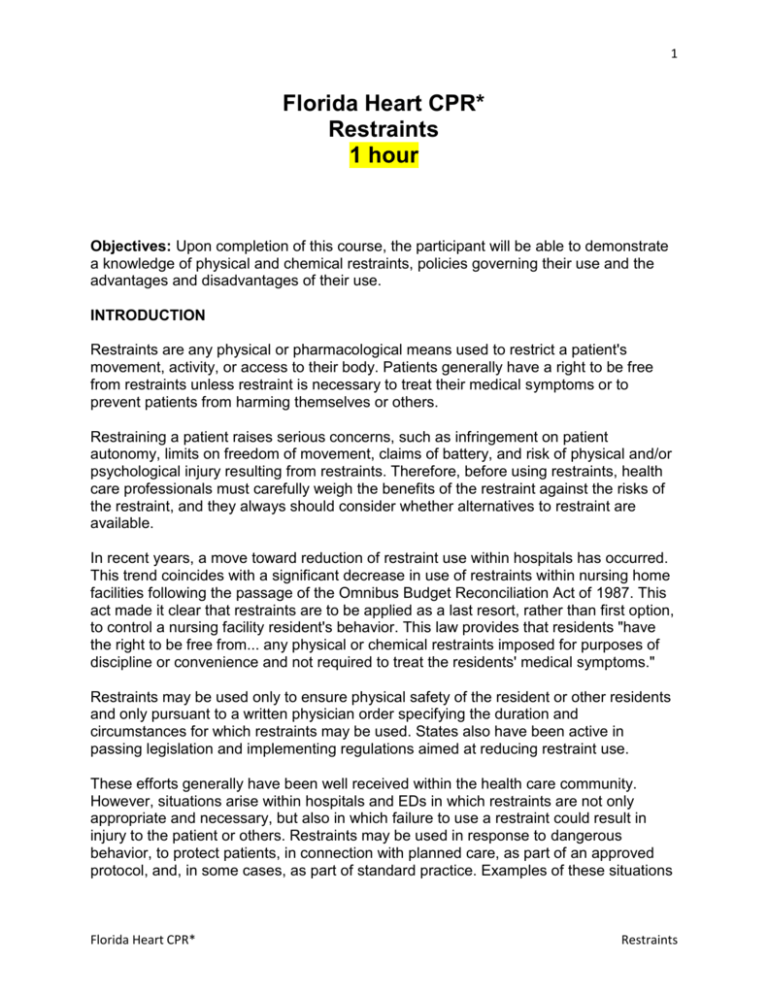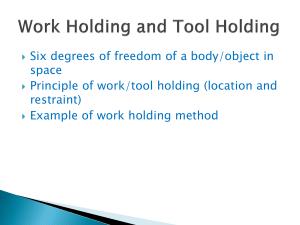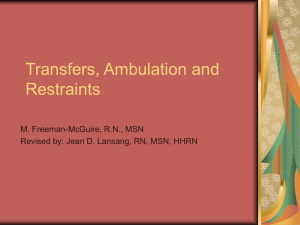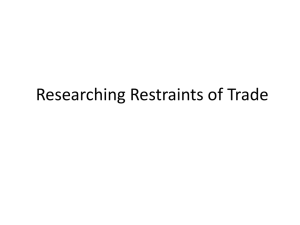Restraints (1) - Florida Heart CPR
advertisement

1 Florida Heart CPR* Restraints 1 hour Objectives: Upon completion of this course, the participant will be able to demonstrate a knowledge of physical and chemical restraints, policies governing their use and the advantages and disadvantages of their use. INTRODUCTION Restraints are any physical or pharmacological means used to restrict a patient's movement, activity, or access to their body. Patients generally have a right to be free from restraints unless restraint is necessary to treat their medical symptoms or to prevent patients from harming themselves or others. Restraining a patient raises serious concerns, such as infringement on patient autonomy, limits on freedom of movement, claims of battery, and risk of physical and/or psychological injury resulting from restraints. Therefore, before using restraints, health care professionals must carefully weigh the benefits of the restraint against the risks of the restraint, and they always should consider whether alternatives to restraint are available. In recent years, a move toward reduction of restraint use within hospitals has occurred. This trend coincides with a significant decrease in use of restraints within nursing home facilities following the passage of the Omnibus Budget Reconciliation Act of 1987. This act made it clear that restraints are to be applied as a last resort, rather than first option, to control a nursing facility resident's behavior. This law provides that residents "have the right to be free from... any physical or chemical restraints imposed for purposes of discipline or convenience and not required to treat the residents' medical symptoms." Restraints may be used only to ensure physical safety of the resident or other residents and only pursuant to a written physician order specifying the duration and circumstances for which restraints may be used. States also have been active in passing legislation and implementing regulations aimed at reducing restraint use. These efforts generally have been well received within the health care community. However, situations arise within hospitals and EDs in which restraints are not only appropriate and necessary, but also in which failure to use a restraint could result in injury to the patient or others. Restraints may be used in response to dangerous behavior, to protect patients, in connection with planned care, as part of an approved protocol, and, in some cases, as part of standard practice. Examples of these situations Florida Heart CPR* Restraints 2 include the following: Protect patients from physically harming themselves (eg, self-extubation) Protect staff and/or patients' families from patient violence Allow assessment of disoriented and uncooperative patients or those under the influence of alcohol or drugs Facilitate medically necessary procedures (eg, gastric lavage) in uncooperative patients Prevent elopement while patients are being evaluated for potential suicidal or homicidal behavior Protect disoriented patients from falls STANDARDS GOVERNING HOSPITAL POLICIES Whenever restraints are employed, their use must be consistent with federal and state laws, hospital licensing regulations, applicable accreditation requirements (including those imposed by the Joint Commission for Accreditation of Healthcare Organizations [JCAHO]), and, most importantly, sound clinical judgment. At a minimum, hospital policies should set forth the following standards (based in part on JCAHO): Restraint use is based on the assessed needs of patients and only may be used to treat patients' medical symptoms or to prevent patients from harming themselves or others. Never use restraints for discipline or staff convenience. Use the least restrictive method of restraint. Use restraints only in accordance with the written order of a licensed independent practitioner (LIP) or as part of an established hospital clinical protocol. LIPs most often are physicians. However, depending on state laws governing the scope of practice, LIPs could include physicians' assistants or nurse practitioners. Furthermore, situations may occur in which appropriately trained supervisory/professional licensed personnel, such as a clinical nurse manager, may initiate restraints in an emergency situation before obtaining the written order. Written orders for restraints should include the time limitation, start and end times, type of restraint, and the frequency of monitoring and reevaluation if it differs from hospital policy. Time limitations should not exceed 24 hours. If the patient is restrained because of primary behavioral health needs, the order should not exceed 4 hours for adults, 2 hours for children aged 9-17 years, and 1 hour for children younger than 9 years. Clinical protocols may include standing as needed (prn) restraint orders as part of medical, dental, diagnostic, or surgical care procedures. Such protocols must set forth patient criteria related to initiation, discontinuation, or reapplication of restraints. Prn orders are never appropriate for patients with primary behavioral health needs (only individual written orders are appropriate). However, if a behavioral Florida Heart CPR* Restraints 3 health patient is being treated for an acute condition and meets the criteria set forth in a clinical protocol, the patient may be restrained pursuant to the prn restraint order set forth in that protocol. States have enacted laws governing restraint use when treating mental/behavioral health problems. Frequency, nature, and extent of monitoring and reassessment of patients in restraints must be defined. Monitoring must be performed by direct observation of and interaction with the patient; it must include an evaluation of the continuing need for restraints and a determination regarding the patient's well-being. Documentation in the medical record should include clinical justification of the necessity for restraints, a written order that complies with hospital policy, and measures taken to protect the patient's rights, dignity, and well-being (eg, monitoring, reassessment, attention to patient needs). Establish criteria for removal of restraints before the written order expires; base the criteria upon the staff's clinical evaluation that restraints are no longer necessary (eg, patient is no longer disoriented and is able to cooperate). Criteria for renewal of restraint orders also should be delineated. Hospitals should institute procedures for implementing policies aimed at reducing and limiting use of restraints, educating staff on alternatives to restraints, and educating staff on proper use of restraints in compliance with hospital policy. Restraint use should be limited to individuals specifically trained to correctly use and monitor patients in restraints. Failure to correctly use or monitor patients in restraints can lead to serious injury or even death. To assist hospitals in evaluating their own performance, consider establishing a central data collection system to review appropriateness of restraint usage and assist hospitals in identifying inappropriate use. Policies and procedures should be reviewed annually and updated as needed. POLICY IMPLEMENTATION When restraints are necessary, practitioners must determine the most appropriate and least restrictive device that allows the patient to retain as much dignity as possible. For example, the following physical restraints are appropriate for the following situations: Posey vests to prevent disoriented patients from climbing off carts (JCAHO does not consider side rails to be a restraint) Soft wrist restraints to protect confused patients from extubating themselves Security or sitters to monitor patients being evaluated for suicidal ideation Limb restraints (eg, upper, lower, 4-point, opposites, soft, leather) to restrain violent patients A team of several members working together (eg, security, medical personnel) may be the best way to restrain a violent patient. Appearance of a team may convince a patient to permit application of restraints without resistance. Ideally, each team member is Florida Heart CPR* Restraints 4 responsible for immobilizing one extremity. This team approach minimizes risk of injury to the patient and staff. Although physical restraints generally are the first method employed when restraints are necessary, pharmacological restraints may be used as an alternative or adjunct to physical restraints. COMPLICATIONS Patients may have injuries that result from being restrained. Most injuries are minor and include abrasions and bruises. However, more serious injuries can occur if restraints are inappropriately applied or the patient is not adequately monitored. For example, a restrained patient could overturn a cart. Complications from pharmacological sedation are more numerous than from physical restraints. Uncooperative patients often provide inadequate histories, which presents increased possibility for allergic reactions. Over-sedation could lead to loss of gag reflex, compromising the patient's ability to protect the airway. A patient who vomits while in 4-point restraints risks choking and aspiration. Pulse oximetry testing may be helpful in monitoring such patients. Patients who are being restrained after an overdose pose particular problems because the ingested substances often are unknown. Sedation could lead to drug interactions with adverse effects. For example, do not administer medication with anticholinergic adverse effects to patients who ingested an anticholinergic poison. Staff considerations Use caution whenever caring for patients in restraints. Staff injuries can occur from violent behavior, such as biting, scratching, spitting, and kicking. At times, gloves and/or masks can enhance staff protection. Be on the lookout for patients with concealed weapons or dangerous objects (eg, needles). CHEMICAL RESTRAINTS Chemical restraints are any medication used for the purpose of restraining patients involuntarily to prevent them from harming themselves or staff. The intent of such medications is long duration of action compared to the brief conscious sedation commonly used to facilitate procedures such as suturing, scanning, and joint reduction. Advantages of chemical restraints Control violent behavior and patient agitation Florida Heart CPR* Restraints 5 May reduce need for physical restraints Allow examination and performance of radiographic imaging Disadvantages of chemical restraints May result in complications, such as respiratory depression and loss of gag reflex Occasional paradoxical reaction results in increased agitation Limit mental status assessment and neurologic examination during sedation Agents A myriad of medications can be used to sedate patients. The ideal agent would last hours, be easily reversible, be available intravenously (IV) and intramuscularly (IM), not depress respirations or gag reflex, not result in hypotension, and not require cardiac monitoring. Unfortunately, no agent is ideal. Agents commonly used to achieve rapid tranquilization fall into categories of major tranquilizers/neuroleptic agents and benzodiazepines. Major tranquilizers/neuroleptic agents o Haloperidol (Haldol) decreases agitation and violent behavior and often is prescribed for acutely psychotic patients. Haloperidol can be used to reduce violent behavior in severely intoxicated patients. Adult dose is 2-5 mg IM; depending on patient response, subsequent doses can be administered as often as every hour, although every 4-8 hours may be satisfactory. Onset of action occurs within 1 hour. Duration of action is 4-8 hours. Adverse effects include extrapyramidal symptoms (eg, dystonic reactions, akathisia), hypotension, prolongation of QT interval, lower seizure threshold, and anticholinergic effects. Benzodiazepines o Diazepam (Valium) is widely used for sedation, treatment of agitation secondary to alcohol withdrawal and treatment of seizures. It has a high therapeutic-to-toxic ratio. Respiratory depression and impaired gag reflex are rare when used alone. Adult dose is 2-10 mg IV/IM; titrate dose if IV. Onset of action is 1-5 minutes for IV dose. Duration of action is 30-60 minutes for IV dose. Adverse effects include interactions with other sedatives, which commonly result in respiratory depression and loss of gag reflex, exacerbation of glaucoma, and paradoxical reactions. o Lorazepam (Ativan) is commonly used to sedate elderly patients and has a wide safety margin. Respiratory depression and loss of gag reflex usually do not result if recommended doses are used. Duration of action is Florida Heart CPR* Restraints 6 long. o o Adult dose is 0.5-4 mg IV/IM; titrate dose if IV. Onset of action is 5-10 minutes for IV dose. Duration of action is 4-8 hours. Adverse effects include exacerbation of glaucoma, respiratory and gag reflex, depression (especially when combined with other sedatives or narcotics), and fetal damage. Midazolam (Versed) is commonly used for rapid sedation in emergency settings because of its rapid onset and brief duration of action. Adult IV dose is 1-2.5 mg initially over 2 minutes; reduce dose if patients are elderly or debilitated; allow 2 or more minutes to evaluate response; titrate slowly. Adult IM dose is approximately 5 mg; reduce dose if patients are elderly or debilitated. Onset of action is 1-5 minutes for IV dose and 15 minutes for IM dose. Duration of action is 30-60 minutes. Adverse effects include respiratory depression (especially when combined with other sedatives or narcotics) and exacerbation of glaucoma. Alprazolam (Xanax) often is used to reduce anxiety. It is not an effective medication for sedation or chemical restraint in the emergency department. Alprazolam is not available for IV or IM administration. Precautions Patient dosing is very variable. More medication may be administered if inadequate sedation results after initial dose. Monitor for respiratory depression and loss of gag reflex. Immediate inadequate sedation may not mean that medication is inappropriate for the patient. The peak effect may be delayed, or additional doses may be required. Consult appropriate references for full prescribing and adverse effect information. Chemical restraints can be an effective adjunct or replacement for physical restraints. SUMMARY Appropriate use of restraints in the ED promotes patient and staff safety. Use should be pursuant to hospital policy for limited periods. Documentation should reflect the need for restraints for medical or safety reasons. Hospitals and health care professionals can incur liability from inappropriate use of restraints and for failure to use restraints to protect a patient; each situation in which use of restraints is considered must evaluated be carefully. Florida Heart CPR* Restraints 7 BIBLIOGRAPHY COBRA: The Consolidated Omnibus Budget Reconciliation Act. 1987. ILCS: Illinois compiled statutes: health facilities nursing home care act. Available at: http://www.legis.state.il.us ILCS: Rights of recipients of mental health and developmental disabilities services. Chap 6. Available at: http://www.legis.state.il.us Joint Commission on Accreditation of Healthcare Organizations: Comprehensive Accreditation Manual for Hospitals: The Official Handbook (CAMH). 1997. Joint Commission on Accreditation of Healthcare Organizations: Comprehensive Accreditation Manual for Hospitals: The Official Handbook (CAMH). 1998. Joint Commission on Accreditation of Healthcare Organizations: Comprehensive Accreditation Manual for Hospitals: The Official Handbook (CAMH). Standards, Intents and Examples of Special Procedures. 1998. Joint Commission on Accreditation of Healthcare Organizations: Comprehensive Florida Heart CPR* Restraints Assessment 1. Restraints are any _________ means used to restrict a patient's movement, activity, or access to their body. a. Physical b. Psychological c. Pharmacological d. A and C 2. Restraints may be used only to ensure physical safety of the resident or other residents and only pursuant to a ______specifying the duration and circumstances for which restraints may be used. a. Physicians request b. Written physician order c. Psychiatrist’s request d. Nurse’s order 3. States also have been active in passing legislation and implementing regulations aimed at ______ restraint use. a. Regulating b. Increasing c. Reducing d. Broadening 4. Restraints may be used in response to a. dangerous behavior b. as part of an approved protocol Florida Heart CPR* Restraints 8 c. to protect patients d. all of the above 5. Never use restraints for a. Safety b. Discipline or staff convenience c. Fun d. B and C 6. Hospitals should institute procedures for implementing policies aimed at: a. reducing and limiting use of restraints b. educating staff on alternatives to restraints c. educating staff on proper use of restraints in compliance with hospital policy d. all of the above 7. Soft wrist restraints may be used to a. protect confused patients from extubating themselves b. prevent disoriented patients from climbing off carts c. restrain violent patients d. monitor patients being evaluated for suicidal ideation 8. Posey vests may be used to a. protect confused patients from extubating themselves b. prevent disoriented patients from climbing off carts c. restrain violent patients d. monitor patients being evaluated for suicidal ideation 9. ________may be the best way to restrain a violent patient. a. Limb restraints b. Posey vests c. Pharmacological restraints d. A team of several members working together (eg, security, medical personnel) 10. Complications from ______ are more numerous than from physical restraints. a. Pharmacological sedation b. Accidental sedation c. Voluntary sedation d. None of the above Florida Heart CPR* Restraints







